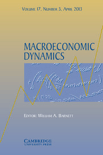
MACROECONOMIC DYNAMICS
Scope & Guideline
Unraveling Macroeconomic Theories and Practices
Introduction
Aims and Scopes
- Macroeconomic Theory and Models:
The journal publishes work that develops and critiques macroeconomic models, including those that incorporate aspects like behavioral economics, monetary policy, and fiscal dynamics. This includes both traditional DSGE models and new approaches that address complex economic interactions. - Empirical Analysis of Economic Dynamics:
A strong focus on empirical studies that utilize data to analyze macroeconomic trends, policy impacts, and economic fluctuations. This includes quantitative analyses using advanced econometric techniques. - Interdisciplinary Approaches:
Research that integrates insights from different fields such as finance, sociology, and political economy to better understand macroeconomic dynamics. This includes studies on the effects of demographics, technology, and policy on economic performance. - Policy Implications and Recommendations:
Many papers address the implications of research findings for economic policy, providing insights on how various fiscal and monetary policies can influence macroeconomic stability and growth. - Global Economic Interactions:
The journal explores the interconnectedness of global economies, including the impact of international trade, capital flows, and global financial markets on domestic economic conditions.
Trending and Emerging
- Behavioral Economics and Expectations:
There is a growing emphasis on behavioral aspects of economic decision-making, including how expectations shape consumer behavior and market dynamics. This trend reflects a broader recognition of the limitations of traditional rational agent models. - Digital Currencies and Monetary Policy:
The exploration of central bank digital currencies (CBDCs) and their implications for monetary policy is gaining traction, reflecting the increasing relevance of digital finance and its potential to transform economic systems. - Inequality and Economic Resilience:
Research examining the interactions between economic inequality and macroeconomic stability is on the rise. This reflects a growing awareness of how disparities in wealth and income can affect overall economic performance. - Environmental Economics and Sustainability:
There is a notable increase in papers addressing the economic implications of environmental policies and sustainability, especially in the context of climate change and resource allocation. - Technological Change and Automation:
Studies focusing on the impact of technological advancements and automation on labor markets and economic growth are becoming more prominent, highlighting the challenges and opportunities presented by rapid technological change.
Declining or Waning
- Traditional Macroeconomic Indicators:
There has been a noticeable decline in research centered around traditional macroeconomic indicators like GDP growth alone, as newer studies tend to focus on more nuanced measures of economic performance, including well-being and inequality. - Linear Models of Economic Dynamics:
Research relying heavily on linear models and assumptions is becoming less frequent, as there is a growing preference for non-linear models that better capture the complexities of real-world economic behavior. - Static Analysis of Fiscal Policy:
Studies that provide static analysis of fiscal policies without considering dynamic interactions over time are appearing less often, as researchers increasingly emphasize the importance of time-varying and adaptive policy frameworks. - Simplistic Views on Monetary Policy:
Papers that offer overly simplistic views on monetary policy, such as those that do not account for the effects of expectations or behavioral responses, are becoming less common as the discourse shifts to more comprehensive frameworks. - Focus on Isolated Economies:
There is a decrease in research that studies economies in isolation without considering global influences, as the interconnected nature of economies is increasingly recognized.
Similar Journals
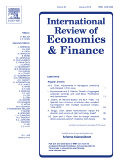
International Review of Economics & Finance
Unlocking Insights for a Global Economic Perspective.International Review of Economics & Finance is a premier academic journal published by ELSEVIER, dedicated to advancing the fields of economics and finance through high-quality, peer-reviewed research. With a distinguished history dating back to 1992 and set to continue until 2024, this journal holds an impressive Q1 ranking in both Economics and Econometrics and Finance categories as of 2023, showcasing its influential role in shaping scholarly discussions. The journal’s focus on empirical and theoretical advancements makes it an essential resource for researchers, professionals, and students seeking to understand and engage with cutting-edge economic and financial theories. Indexed in Scopus, the journal ranks in the top tiers for both finance and economics, underscoring its global impact within these disciplines. Although it does not offer open access, the journal remains committed to disseminating vital insights and fostering ongoing dialogue in the academic community.
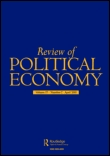
REVIEW OF POLITICAL ECONOMY
Engaging Minds in Rigorous Political Economic DebateThe Review of Political Economy, published by Taylor & Francis Ltd, stands as a premier journal in the fields of Political Science and Economics, with an impressive 2023 Q1 ranking in both categories. With an ISSN of 0953-8259 and an E-ISSN of 1465-3982, the journal offers a dynamic platform for rigorous scholarly debate and critical analysis since its inception in 1989. Located in the United Kingdom, the journal focuses on current political economic issues, engaging researchers, professionals, and students alike. Its ability to converge disciplines has made it a vital source of insights for those navigating the complex intersections of politics and economics, firmly establishing its relevance in contemporary academic discourse. Although not an open access journal, its contributions to the field are invaluable, underlined by robust Scopus rankings that reflect its influence and quality. By connecting theory with practice, the Review of Political Economy continues to inspire and inform critical discourse within the global academic community.

Eurasian Economic Review
Fostering impactful dialogue in economics and finance.Eurasian Economic Review is a premier academic journal dedicated to the dissemination of high-quality research in the field of economics, notably within the Eurasian context. Published by SPRINGER HEIDELBERG in Switzerland, this journal stands out with an impressive Q2 ranking in the 2023 category of Economics, Econometrics and Finance, reflecting its influential role in fostering scholarly dialogue. The journal encompasses a broad array of topics related to economic trends, policy impacts, and theoretical advancements, making it an essential resource for researchers, professionals, and students alike. With a consistent output since its inception in 2011, the Eurasian Economic Review is committed to providing open access to its valuable content, ensuring that important findings are widely available to the global research community. As a member of the top 9th percentile in Scopus rankings for its field, this journal uniquely positions itself as a vital conduit for innovative and impactful research in economics.
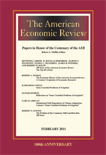
AMERICAN ECONOMIC REVIEW
Where Economic Insights Meet Academic Excellence.AMERICAN ECONOMIC REVIEW, published by the American Economic Association, stands as one of the most prestigious academic journals in the field of Economics and Econometrics. With an impressive impact factor and ranking of #9 out of 716 in its category, this journal has achieved a notable position within the top 2% of journals globally, as evidenced by its Q1 classification in 2023. Covering a broad spectrum of economic theory and applied research, it serves as a primary platform for the dissemination of high-quality scholarly work, contributing significantly to the ongoing dialogue within the discipline. Although Open Access options are not available, the journal's rigorous peer-review process ensures that published articles uphold the highest standards of academic integrity and relevance. With coverage spanning from 1973 to 2024, the AMERICAN ECONOMIC REVIEW continues to be an essential resource for researchers, professionals, and students eager to stay at the forefront of economic thought and innovation.

OPEN ECONOMIES REVIEW
Connecting Scholars to Economic Innovations.OPEN ECONOMIES REVIEW is a distinguished journal, published by SPRINGER in the field of economics and econometrics, dedicated to exploring the complexities of global economic interactions and policy implications. With its ISSN 0923-7992 and E-ISSN 1573-708X, this journal serves as a vital platform for scholars and practitioners alike, offering insights that bridge theoretical and empirical research. Established in 1990, it is set to continue its impactful journey through 2024, showcasing research that is ranked in the top quartile (Q2) of its category for 2023 and positioned in the 46th percentile overall among economic journals. Although not an open-access journal, it ensures comprehensive accessibility to cutting-edge findings and methodologies in economics, contributing to informed decision-making and policy development. Situated in the Netherlands at VAN GODEWIJCKSTRAAT 30, 3311 GZ DORDRECHT, this publication is essential for researchers, professionals, and students seeking to navigate the dynamic landscape of global economies.
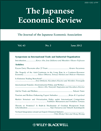
JAPANESE ECONOMIC REVIEW
Advancing insights into Japan's economic landscape.Japanese Economic Review, published by Springer Heidelberg, is a renowned academic journal that aims to advance the understanding of economic processes within the context of Japan and the Asia-Pacific region. With an ISSN of 1352-4739 and E-ISSN of 1468-5876, this journal features high-quality research articles that span a broad range of topics in economics and econometrics. Ranked in the Q2 category for Economics and Econometrics as of 2023, it holds a Scopus rank of #332 out of 716, placing it in the 53rd percentile among its peers. Although not Open Access, the journal invites contributions that provide insights and empirical analyses beneficial to both academics and practitioners. Emphasizing a deep understanding of economic dynamics, the Japanese Economic Review is essential reading for anyone interested in the implications of economic policies and trends, making it a significant platform for scholarly dialogue and research dissemination.
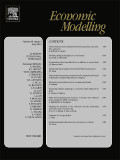
ECONOMIC MODELLING
Elevating Economic Analysis to New Heights.ECONOMIC MODELLING, published by Elsevier, is a leading academic journal in the field of Economics and Econometrics, with a commendable impact factor that underscores its significance within the research community. Since its inception in 1984, this journal has been pivotal in disseminating high-quality research that contributes to the advancement of theoretical and empirical methodologies in economics. As a Q1 journal in its category, it ranks in the top 88th percentile according to Scopus, solidifying its reputation as an influential platform for economists and academicians. Although it does not offer open access, the journal maintains a robust subscription model, ensuring wide distribution of critical insights and findings. Researchers, practitioners, and students are encouraged to engage with the latest developments in economic modelling, making ECONOMIC MODELLING an essential resource for anyone seeking to understand and contribute to the evolving landscape of economic theory and application.
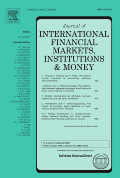
Journal of International Financial Markets Institutions & Money
Illuminating the Dynamics of Global MarketsThe Journal of International Financial Markets, Institutions & Money, published by Elsevier, serves as a leading platform for the dissemination of high-quality research in the fields of finance, economics, and econometrics. With an impressive impact factor reflected in its status as a Q1 journal in both categories for 2023, it ranks among the top journals, positioned at #47 out of 317 in Finance and #111 out of 716 in Economics. This journal offers a unique focus on the interplay between financial markets and institutions on a global scale, making it an essential resource for scholars, practitioners, and students alike. The journal welcomes innovative theoretical, empirical, and applied research, contributing to an exciting dialogue that shapes the future of international finance. For researchers looking to publish their findings, this journal is committed to rigorously engaging with contemporary financial phenomena, positioning itself as a vital cornerstone of academic and professional discourse.
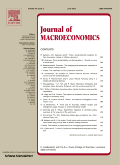
JOURNAL OF MACROECONOMICS
Transforming Data into Economic InsightsJOURNAL OF MACROECONOMICS, published by Elsevier, stands as a significant platform for scholarly discourse in the field of economics and econometrics. With an ISSN of 0164-0704 and an E-ISSN of 1873-152X, this journal has been actively contributing to the academic community since 1979 and continues to publish impactful research through 2024. It is recognized within the Q2 category for Economics and Econometrics in its 2023 quartile rankings, and it holds a respectable Scopus ranking of #353 out of 716 in its field, placing it in the 50th percentile. Despite not being an open-access journal, it provides valuable insights into macroeconomic theories, empirical assessments, and policy implications, making it an essential resource for researchers, professionals, and students aiming to deepen their understanding of macroeconomic dynamics. To access a breadth of contemporary research and enhance your academic pursuits, consider diving into the latest issues of this esteemed journal, conveniently located in Amsterdam, Netherlands, at RADARWEG 29, 1043 NX.
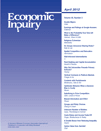
ECONOMIC INQUIRY
Catalyzing Discourse in Economic Research and Practice.ECONOMIC INQUIRY, published by Wiley, is a prestigious academic journal that has been at the forefront of research in economics and management since its inception in 1962. With an ISSN of 0095-2583 and an E-ISSN of 1465-7295, this journal is renowned for its rigorous peer-reviewed articles, embracing a wide scope of economic and econometric inquiries. Its impressive placement in the Q1 category for both Business, Management and Accounting, and Economics and Econometrics highlights its significance within these fields. With a Scopus rank placing it in the top quartile of Economics and Econometrics journals, alongside a ranking for Business studies, it caters to a diverse audience of researchers, professionals, and students eager to deepen their understanding of economic phenomena. Although it operates under a traditional subscription model and does not offer open access, the journal's contributions are instrumental in advancing knowledge and discourse in economic theory and practice, making it an essential resource for anyone involved in this vibrant discipline.